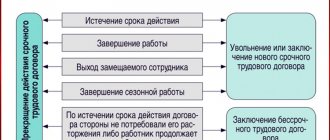Civil Code of the Russian Federation:
Article 410 of the Civil Code of the Russian Federation. Termination of obligation by offset
The obligation is terminated in whole or in part by offsetting a counterclaim of the same type, the due date of which has come or the due date of which has not been specified or is determined by the moment of demand. In cases provided for by law, it is allowed to set off a counterclaim of the same type that has not yet reached its due date. For offset, a statement from one party is sufficient.
Return to the table of contents of the document: Civil Code of the Russian Federation Part 1 in the current edition
What is offset
The Civil Code of the Russian Federation provides for various methods of repaying debts to creditors. The obligations of the parties are terminated on the grounds provided for by law, regulations or agreement (Article 407 of the Civil Code of the Russian Federation). The obligations of the parties can be terminated by proper execution of the contract (Article 408 of the Civil Code of the Russian Federation), by providing compensation - payment of funds or transfer of property (Article 409 of the Civil Code of the Russian Federation) or as a result of debt forgiveness (Article 415 of the Civil Code of the Russian Federation). The most common form of non-monetary settlements between organizations that are both creditors and debtors in relation to each other is mutual offset - set-off of mutual claims (Article 410 of the Civil Code of the Russian Federation).
Settlement of mutual claims is a written agreement between two organizations on the mutual repayment of obligations that are similar in content. These obligations include requirements for payment for various goods, services or work. Using an example, it might look like this: we provide accounting services, our client develops websites. At some point, we decided to order a website for a separate project and agreed to offset the services; after 2 months we accepted the work for 50 thousand rubles. according to the act, signed a statement of reconciliation of calculations, issued an act of offset of accounting services for website development services.
Settlement is possible for two or more obligations. Two or more organizations can act as participants in mutual offset transactions, provided that the listed requirements are met. For offset, a statement from one party is sufficient. However, in practice, the decision to set off is made by all parties.
When is offset possible?
In Art. 410 of the Civil Code of the Russian Federation establishes the basic requirements for conducting mutual offsets between organizations:
- homogeneity of counterclaims, i.e. the parties’ requirements for each other must be qualitatively comparable;
- the maturity date of obligations, i.e. a netting transaction is valid if the terms for repayment of obligations - a) have already arrived, b) are either not specified, c) or are determined by the moment of demand;
- in cases provided for by law, it is allowed to set off a counterclaim of the same type that has not come due.
In what cases is offset not possible?
Art. 411. The Civil Code of the Russian Federation contains a list of situations when offset is unacceptable for obligations:
- for compensation for harm caused to life or health;
- about lifelong maintenance;
- on the collection of alimony;
- for which the statute of limitations has expired;
- in other cases provided for by law or agreement.
Other requirements mean special cases, namely:
- if this is specified in the agreement between the parties for the supply of goods, services or works;
— it is not permitted to exempt the notary chamber from the obligation to pay a membership fee to the compensation fund, including by offsetting claims against the Federal Notary Chamber;
— it is not permitted to exempt a member of an association of tour operators in the field of outbound tourism from the obligation to make contributions to the reserve fund, including by offsetting his requirements for the association of tour operators in the field of outbound tourism.
https://youtu.be/https://www.youtube.com/watch?v=eXfiKtKvk50
Comments on Article 410 of the Civil Code of the Russian Federation, judicial practice of application
Comments: “Set-off of counter (mutual) homogeneous claims. Applications and agreements on offset of claims (samples)"
- Agreement on set-off of counterclaims of the same type. Sample (as a result of the offset, the debt of one of the parties is repaid in full, the other party undertakes to repay the debt within the prescribed period);
- Application for offset of similar counterclaims. Sample (after offset of mutual homogeneous claims, there is a balance of the applicant's debt. The debt of the other party to the applicant has been repaid in full).
The procedure for conducting and registering mutual offsets
Settlement can be done in two ways
- notification of the fact of offset,
- Set-off agreement (document - agreement, agreement or deed) signed by both parties.
Each of these methods has pros and cons.
The first option - Notification of mutual offset - is a simple way to complete it, takes little time, and does not require the consent of the parties. The notice is sent by registered mail with notification and is effective from the moment of receipt by the other party. However, this does not mean the consent of the other party and may serve as a basis for disputes.
The second option, the Settlement Agreement , minimizes disputes between counterparties. The agreement both serves as a waiver of the party's right to claim the statute of limitations has expired and acknowledges the existence of a debt. In addition, such agreements are signed, as a rule, by the executive body of the company, which reduces the likelihood of the counterparty refusing the fact of offset on the grounds that the notice of offset was not received or was received by an unauthorized person. We recommend using the form of a bilateral document - an Agreement or a Deed, which we will discuss further.
We fix the debt in a document of mutual claims
Before drawing up the act, we recommend that you sign a Reconciliation Report of Mutual Settlements . This document is optional, but it will help confirm the amount of debt (especially if part of the debt has already been previously paid) and avoid unnecessary disputes with the counterparty. The decision on offset is drawn up using the appropriate document (Act or Agreement), drawn up in any form. The document on mutual settlement comes into force from the moment it is signed by the parties.
We recommend that you sign a reconciliation report for mutual settlements with your counterparty. This document is optional, but it will help confirm the amount of debt (especially if some of the debt has already been paid) and avoid unnecessary disputes with the counterparty.
The document for offsetting mutual claims of legal entities (sample Act, sample Agreement) must contain the following necessary information:
- details of the documents on the basis of which the debt was formed (number, name, date);
- the amount of total debt of the parties, including VAT;
- the amount of debt to be repaid through a netting operation, indicating VAT.
If there are more than two organizations, the document additionally indicates: a list of participants in the netting, the amounts of receivables and payables of each participant before the netting, acts of reconciliation of the participants in the netting, the amounts of receivables and payables of each participant after the netting.
The document must be signed by authorized representatives of the parties (manager, chief accountant).
Requirements for drawing up an act
A clearly defined form of agreement is not established by law. However, there are generally accepted requirements for the information it contains. The act must necessarily stipulate the following:
- date and place of conclusion of the agreement;
- names of commercial organizations, full names of their representatives, as well as on what basis they operate;
- detailed information on each obligation eliminated by the offset method (details of the agreement, content and scope of the obligation);
- information about the status of each counterparty - debtor or creditor;
- indication of the amount of debt repayment (full or partial);
- date of entry into force of the agreement;
- details and coordinates of the parties.
Also, in the netting act, you should note not only the date the document was drawn up, but also the date the debt was created and the date of its repayment. This is necessary for the correct calculation of taxes.
Rules for netting
Offsetting is subject to the following requirements:
- There must be a fact of the appearance of claims , which must be homogeneous.
- Organizations conducting offset of claims will immediately take part in several obligations for which counter requests have appeared.
- All requests must be counter or cyclical in nature.
Settlement will be prohibited for the following claims:
- Lifetime content.
- In the event that the limitation period has expired.
- Petition for alimony.
- Compensation for harm caused to health and life.
Offsetting is
Offsetting is an agreement on the mutual repayment of obligations by the parties as a result of payment for work, services, goods, which is documented.
In the process of mutual offset of claims, 2 contracts are concluded . According to them, the timing of the arrival and the rights of claims of the parties are clearly oriented.
Offsetting mutual claims is an operation that causes absolute or partial repayment of obligations by means of offsetting these counter obligations. Their deadline is strictly established, not specified or accomplished.
According to the code, offset is considered to be the repayment of similar counterclaims, or the repayment of promises, obligations under contracts, proposals.
If the requests of the parties are equivalent, the promises of the parties are considered fulfilled.
Sometimes it can be confused with barter. However, such similarity boils down only to the absence of the need for funds when performing offsets.
Requirements for registration of mutual settlement (sample)
The law does not establish a standard form and sample application for offset, that is, today such an application is filled out in any form (the same applies to the act of offset of mutual settlements), however, according to Art. 9. Law of December 6, 2011 No. 402-FZ, the requirements for primary accounting documents must be met.
In order to avoid legal disputes and proceedings, these forms of documents require a detailed description of all the circumstances of the offset.
The standard fill has the following structure:
- Title of the document;
- Date and place of compilation;
- Name and details of the participants in the mutual settlement;
- Foundation documents
- The essence of the requirements and their quantity;
- Credit amount;
- Taxes*;
- A record that the mutual debt is repaid (date of offset);
- Signatures of authorized persons and seals of organizations.
*The amount of VAT, calculated on the basis of the amounts of debts of all parties to the agreement, is written on a separate line and a reference is made to invoices (otherwise there is a high probability of proceedings with the tax service).
Table 3 – Examples of errors in registration of offsets:
| Error | What does this entail? |
| 1) VAT is not allocated as a separate amount for each counter-obligation agreement (absent) | The emergence of disputes, subsequent contractual sanctions, tax sanctions (expenses for which the arrears of payment are not documented in the offset are not recognized |
| 2) Drawing up an agreement on mutual settlement of obligations for which it is illegal | The agreement is declared invalid |
| 3) Requests are made in different currencies | The agreement is declared invalid |
| 4) No counter obligations, for example, we issue a loan to an individual - the general director of a company that provides us with services | The agreement is declared invalid in accordance with Art. 410 of the Civil Code of the Russian Federation, however, the general director can transfer the debt to the company with our consent (Article 391 of the Civil Code of the Russian Federation) and only then will counter obligations arise |
| 5) The offset is made for the amount of the largest debt | The agreement is declared invalid |
Below in Figure 1 is a sample act (agreement) on netting.
Sample act (agreement) on netting
- The agreement contains a transcript of the signatures.
- The duration of the contract is indicated.
- The number of copies corresponds to the number of sides.






